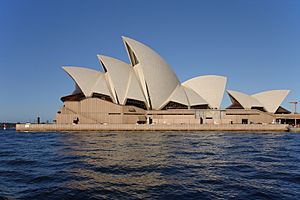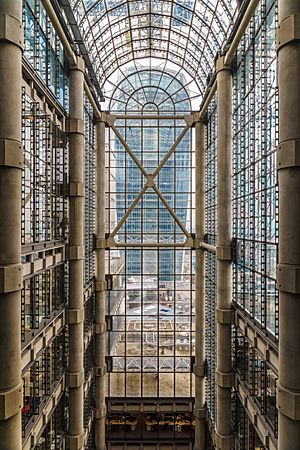Peter Rice facts for kids
Quick facts for kids
Peter Rice
|
|
|---|---|
| Born | 16 June 1935 |
| Died | 25 October 1992 (aged 57) |
| Nationality | Irish citizenship |
| Education | Queen's University of Belfast and Imperial College London, UK |
| Occupation | Engineer |
| Spouse(s) | Sylvia Watson |
| Children | Kieran Rice,Julia Rudin, Heidi Jarossi |
| Engineering career | |
| Discipline | Structural engineer, Engineering design |
| Institutions | Fellow of the Institution of Structural Engineers, Member of the Institution of Civil Engineers Fellow of the Royal Academy of Engineering, Honorary Fellow of the Royal Institution of British Architects |
| Practice name | Ove Arup & Partners |
| Projects | Sydney Opera House Centre Pompidou, Paris Lloyd's of London, the Louvre Pyramid, Paris Stansted Airport, UK |
| Awards | RIBA Gold Medal, IStructE Gold Medal |
Peter Rice (born June 16, 1935 – died October 25, 1992) was a famous Irish structural engineer. He helped design some of the most important buildings in the 20th century.
Peter grew up in Dundalk, Ireland. He studied engineering at Queen's University of Belfast and Imperial College London. He was known for being both an engineer and a designer. This meant he could make buildings strong and safe, but also beautiful and creative.
Contents
Peter Rice: A Creative Engineer
Peter Rice first studied how airplanes are built. But he soon changed to Civil Engineering, which is about designing and building things like roads, bridges, and buildings. His first big job was working on the roof of the Sydney Opera House.
He married Sylvia Watson in 1960. They had one son and three daughters. His son also became an engineer. People often said Peter Rice was like the "James Joyce of structural engineering." This means he was very creative and could think in new ways. He was also very good at math and logic. This made him one of the most wanted engineers of his time.
His Ideas on Building Design
Peter Rice believed that the best buildings happen when architects and engineers work closely together. He thought engineers were like inventors who found solutions. Architects, on the other hand, brought the creative ideas. He felt that in some countries, people didn't fully understand how creative an engineer's job could be.
Famous Buildings He Worked On
Peter Rice worked on many famous buildings around the world. These include:
- The Centre Pompidou in Paris
- The Sydney Opera House in Australia
- The Lloyd's of London building in England
- The Louvre Pyramid in Paris
- The Mound Stand at Lord's Cricket Ground in London
- Kansai International Airport in Japan
- Stansted Airport in the UK
Towards the end of his life, he also helped design the new front of Lille Cathedral in France.
Peter Rice's Career Journey
The Sydney Opera House Project
In 1956, Peter Rice started working for a company called Ove Arup & Partners. He took a break to study more in 1957. Then he came back to Arup's in 1958.
For three years, he worked on the tricky roof design for the Sydney Opera House. He helped figure out the complex shapes needed for the roof shells. At just 28 years old, he moved to Sydney to help build it. His boss got sick, so Peter was suddenly in charge! He even wrote a computer program to make sure all the roof pieces were put in the right place. He spent seven years on this huge project.
The Pompidou Centre and Beyond
In 1971, Peter Rice was part of a team that won a competition to design a new center in Paris called Beaubourg. This building became the Centre Pompidou. He worked with famous architects like Richard Rogers and Renzo Piano.
The Pompidou Centre was very special because it mixed art and technology. Peter Rice helped make sure the building felt human and not just like a machine. His team created a special part called a "gerberette." This helped balance the building's weight and made it look lighter. He made sure these parts were made from strong cast steel.
After the Pompidou Centre, Peter Rice started his own company in 1977 called "RFR." But he also kept working as a partner at Arup. In 1978, he worked with Richard Rogers again on the Lloyd's of London building, which was finished in 1984. During this time, he also worked on a factory in France and Stansted Airport in London.
Work in the 1980s and 1990s
Even though Peter Rice was based in London, he did a lot of work in Paris. He designed the large glass walls for the Cité des Sciences et de l'Industrie museum. He also created a tent-like roof for the Grand Arche at La Défense. In 1985, another famous architect, I. M. Pei, asked for his help with the Louvre Museum in Paris. Peter designed the glass roofs that covered the inner courtyards.
By this time, everyone wanted to work with Peter Rice! He worked with many top architects like Richard Rogers, Norman Foster, and Renzo Piano. His projects ranged from an Opera House in Toronto to the Kansai International Airport in Japan.
Peter Rice was known for his thoughtful approach to design. He was good at solving problems and making ambitious artistic ideas come true. He also took the time needed to complete a project perfectly. His work influenced many future award-winning architects.
New Ways of Building
Peter Rice was a pioneer in using new techniques:
- For the Sydney Opera House, he was one of the first to use advanced computer modeling. This helped them figure out the complex shapes.
- He used a method called post-tensioned concrete to make the roof shells of the Sydney Opera House stronger.
- For the Seville_Expo_'92, he used post-tensioned stone to build an archway. This made stone stronger than usual.
Awards and Recognition
In 1992, Peter Rice received the Royal Gold Medal for Architecture. This is a very important award given by the Royal Institute of British Architects. He was only the second engineer ever to get this award. It's given to people who have greatly helped architecture.
His Passing and Legacy
Peter Rice was diagnosed with a brain tumor in 1991 and sadly passed away the next year at age 57. A sign has been placed outside his childhood home in Dundalk, Ireland, to remember him.
After he died, his book called An Engineer Imagines was published. It became a very important book about building design. There are also awards and medals named after him. The Peter Rice Prize is given at Harvard University. The Peter Rice Silver Medal is awarded to engineering students in his hometown of Dundalk. In 2019, a documentary film about his life, also called An Engineer Imagines, was released.
Projects Peter Rice Worked On
- Sydney Opera House, Sydney, Australia; 1957
- Crucible Theatre, Sheffield; 1967
- Amberly Road Children's Home, London; 1969
- National Sports Centre, Crystal Palace, London; 1970
- Arts Centre, University of Warwick, Coventry; 1970
- Perspex spiral staircase, Andrew Grima jewellery shop, 80 Jermyn Street, London; 1970
- Super Grimentz Ski Village, Valais, Switzerland; 1970
- Conference Centre, Mecca, Saudi Arabia; 1971
- Special structures advice to Frei Otto and others on pneumatic and cable structures including "The City in the Arctic"; 1971
- Centre Pompidou (Beaubourg), Paris, France; 1971
- Jumbo jet hangar, Johannesburg, South Africa; 1976
- TGV Station Lille; 1994
- Mobiles Zelt in London London; 1992
- TGV Station Roissy; 1991–94
- Elektronikfabrik Thomson Saint-Quentin-en-Yvelines; 1990
- Umbau des Louvre Paris-1er; 1988–93
- Cité des Sciences et de l'Industrie Paris-19e; 1986
- De Menil Collection Houston; 1981–86
- IBM Pavillon 1980–84
- 'Quartierslaboratorium' für Stadterneuerung Otranto; 1979
- Residential Complex Corciano; 1978–82
- 'Pabellón del Futuro; Seville, Spain; 1992
Images for kids





